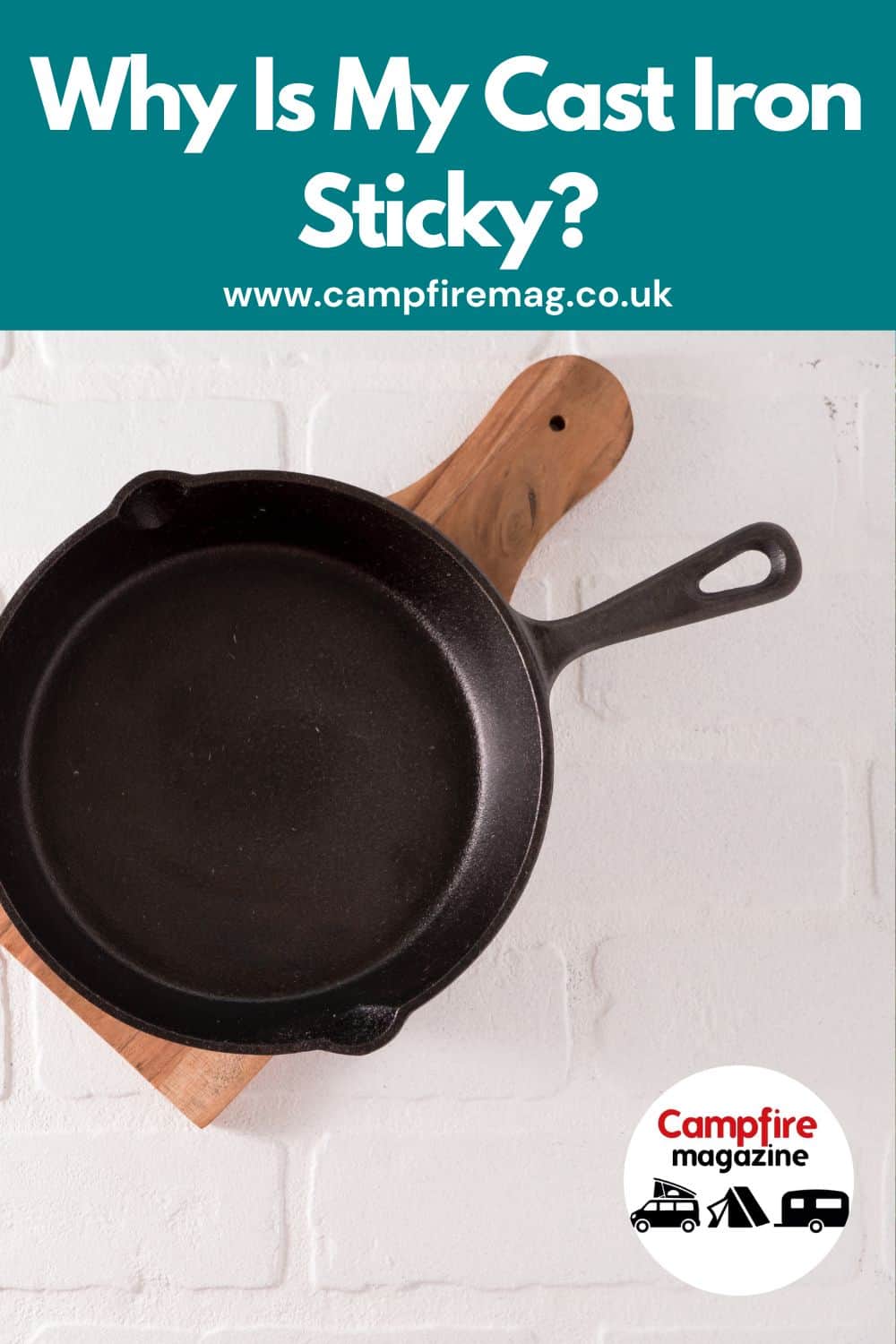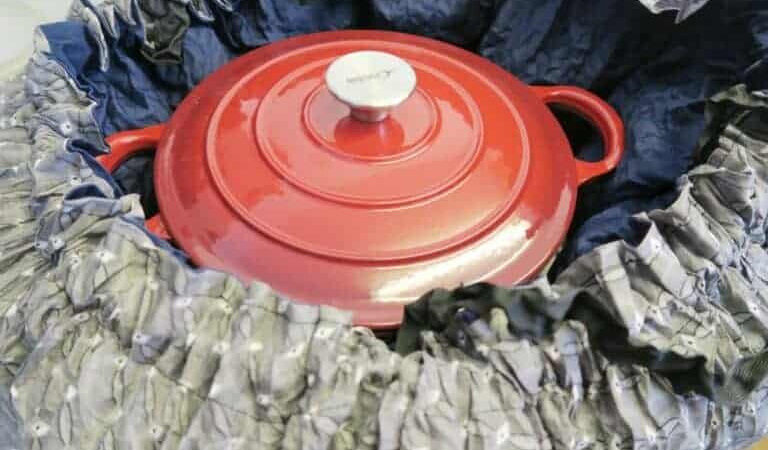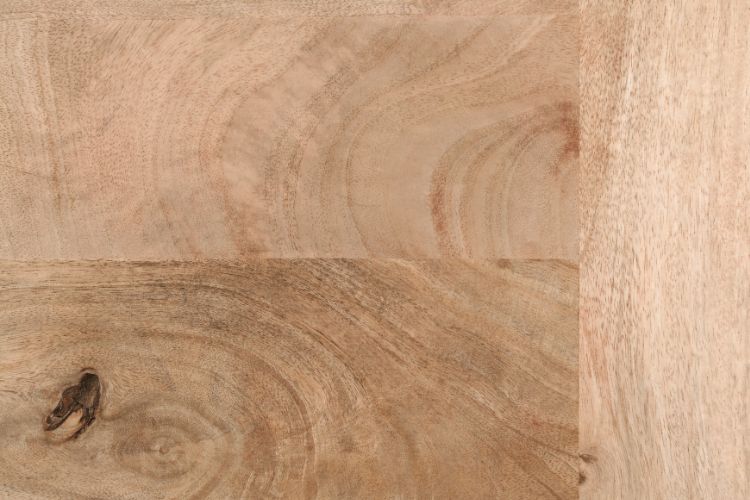Why Is My Cast Iron Sticky?
If you want to get the most out of your cast iron pans then it is essential that you season them. While a lot of people think that this is a pretty easy process, there are some ‘side effects’ if it isn’t done properly. One of the things you might have noticed is that your cast iron pan becomes sticky; but why is this and can it be fixed?

One of the main reasons that a cast iron pan might be sticky is that you have used too much oil and this has caused a build up. It can also be caused by using the incorrect type of oil as well as not using enough heat to seal the oil.
It all sounds a little complicated and could be enough to put you off using cast iron altogether. But don’t let it deter you. A sticky pan can be avoided and there is an easy fix and in this guide, we will tell you everything you need to know.
What’s The Deal With Seasoning?
Before we can properly understand why our cast iron pans may have the sticky layer, it’s essential to get to grips with what seasoning is all about in the first place. The reason that we season cast iron pans is to create a non-stick layer. Moreover, this layer offers protection to the pan against oxidation which can boost corrosion and rust.
When seasoning a cast iron, you must begin by applying a thin layer of oil to the metal. After this, you have to use clean, dry cloth to buff the oil in and get rid of any excess. A lot of people aren’t intense enough when they do this as they think that, if they go over the top, they’ll undo the effort of applying the oil. However, this is not the case. When you buff the oil away, you’re almost trying to get rid of it all so that there isn’t any excess that could lead to that sticky layer.
Remember that cast iron is porous so the minute you apply the oil, it’ll start seeping into the gaps in the metal. Even when you buff the pan to within an inch of its life, there will still be plenty of oil left behind.
The next stage of seasoning is to heat the pan over a high heat and you have to make sure that you do this for a decent amount of time. How hot the pan needs to get will vary depending on the type of oil you have used but it does need to get hotter than the smoke point otherwise it won’t polymerise.
This is when a reaction between the iron, the oil and the oxygen within the air occurs and this makes a hard coating appear on the pan. If you get it right then you will notice that there is a nice smooth layer and no trace of oil or any other liquid. The pan certainly should not be sticky or tacky.
The Proper Way To Season A Cast Iron Pan
We have briefly touched on how to season a cast iron pan but if this is not something you have done before, step by step instructions are going to offer you a clear and simple way of understanding the process. Here’s our how to guide.
-
Start by giving your cast iron a good clean. You can use soap and water and make sure that all grease, oil, dust and any other type of dirt is fully removed. If it isn’t then the pan won’t season properly.
-
When you’re happy with the cleaning results, it’s time to dry your cast iron. Start by wiping it over with a dry cloth and then pop it onto a low heat to make sure that all moisture evaporates. You’ll need to leave it heating for around three minutes.
-
Now it’s time to start the seasoning process and you will need to preheat your pan for around ten minutes at 90 degrees celsius in order to prepare the surface to accept the new coating.
-
Take the pan off of the heat and apply your thin layer of oil both inside and outside using a cloth. Keep in mind that you really don’t need a lot of oil.
-
Take a clean cloth and use this to buff any excess oil away. Don’t be afraid to go hard at it because you’re almost trying to get rid of the oil you have just put on.
-
Next, put your cast iron into a preheated oven with the temperature set to at least 230 degrees celsius. Leave the cast iron in the oven for around one hour.
-
After this, turn off the heat and open the oven door slightly so that the pan can naturally cool down.
-
When it has cooled enough that you can handle it, remove the pan and apply another layer of oil. You’ll then need to repeat the seasoning process a further two to four times.
Why Is My Cast Iron Sticky?
If you follow the seasoning process to the letter then you should find that you don’t have any problems. But as with anything, this is a process that can take some getting used to so don’t kick yourself if you find that your cast iron is a little sticky.
There are a few reasons that this may be the case, so check these out and see if there is anything you could have done differently when seasoning your pan.
You Didn’t Clean The Pan Properly
In the event that there is even the smallest amount of dirt, dust, food or oil left on a cast iron pan before seasoning, this will prevent the oil from being able to bond with the metal. This is why it’s super important to make sure that you pay close attention to the cleaning part of the process.
Use a suitable cleaning aid such as a chainmail sponge, scrubbing brush or something similar and don’t be afraid to use soap as this isn’t going to cause the pan any harm as long as you thoroughly rinse it off when you’re done.
You Went OTT With The Oil
One of the most common mistakes that people make when seasoning a cast iron pan is that they apply too much oil. You need to make sure that you don’t go over the top with this as you’ll end up doing more harm than good.
I once heard the analogy of comparing pan seasoning to painting. When you decorate a wall, you always apply a thin layer and build it up rather than loading on thick layers of paint from the off.
When you season your cast iron, less is always more and you should aim to apply between two and four coats of oil, allowing each one to be heated and dry before applying the next.
When you put your pan in the oven to heat it, make sure to place it upside down as this will stop the oil from settling at the bottom.
You Didn’t Use The Correct Type Of Oil
It’s not unusual for people to think that any type of oil is suitable for cast iron seasoning but this isn’t always the case. While most oils are OK to use, you’ll notice that the seasoning quality differs depending on which you choose.
You need to think about the smoke point of the oil as well as the type of fat that it contains. For example, things like bacon grease, animal fat, lard and butter all contain saturated fat. When they are at room temperature, they are in solid form and their very nature means that they aren’t as easily able to bond with the cast iron so aren’t usually as effective. You may find that using these types of fats results in patchy or uneven results.
On the other hand, oils that remain in a liquid state at room temperature, contain unsaturated fat and these are far better for seasoning cast iron as they don’t have such a hard time bonding with the metal. In fact, what you end up with is a seasoning that is perfectly non-stick and beautifully easy to clean so it’s always better to choose unsaturated fats.
The smoke point of the oil refers to the temperature at which the oil starts breaking down and producing smoke. If you don’t get the oil to reach this point then it isn’t able to bond with the cast iron and the result is that sticky layer we are trying to avoid.
You Seasoned The Pan Without Heating It
Another common mistake is not heating the pan, or not heating it enough before seasoning it. When you heat cast iron, it will expand which means that the oil is more easily able to penetrate the pores. This results in a more robust bond whereas applying oil to a cold pan means it’ll just rest on the surface rather than soaking in.
It’s always best to allow your pan to heat in a medium temperature oven for ten minutes before you go anywhere near it with the oil. Be careful when removing the pan from the oven but you are then free to apply your oil and buff it as per the instructions I gave earlier on.
You Didn’t Set The Oven Temperature Hot Enough
If you have found that you have a sticky layer on your cast iron then it could be that you didn’t get the oven hot enough to cause it to start breaking down the oil. If the oil doesn’t reach its smoke point then you’re going to have a really hard time forming the bond between it and the metal so it’s essential that you set the oven hot enough to achieve this.
One of the things that worries a lot of people when seasoning a cast iron pan is that the oven will begin to smoke. They immediately see this as a worrying sign and take the pain out or turn the temperature down but this ruins the whole process. The smoke might smell or look a little concerning but it isn’t. Without this reaction, the pan will not season so make sure to keep the temperature to at least 230ºC for the whole time.
You Didn’t Season The Pan For Long Enough
Similarly to the above point, some people don’t like the look or smell of the smoke and so take the cast iron out of the oven before the hour is up. Doing this is going to cut the process short and won’t result in the smooth, mirror-like finish. Even after just one hour in the oven, the seasoning may not be even, so it’s highly likely that you’ll need to do a further two, three or even four rounds.
You Didn’t Use The Oven To Heat The Cast Iron
Some people think that omitting the oven and just seasoning the cast iron on the stove will be quicker and easier. But this isn’t the case and if you do this, you’re pretty much guaranteed to end up with a sticky cast iron.
The problem with doing it this way is that you don’t get the even heating that you do in the oven. It’s only the bottom of the pan that’s getting most of the heat while the rest stays comparatively cool. This means that polymerisation cannot occur and you get that sticky result.
Can I Still Use A Sticky Cast Iron?
In theory, yes, you can use your cast iron pan if it is sticky but it’s not something I’m going to advise you to do. You see, when you cook, you’re going to need to add more oil to your cast iron. Since the reason for the stickiness is that there is already too much oil, adding more isn’t going to make matters any better.
In fact, it’s highly likely that you’ll just end up creating even more problems and you could end up with a layher so sticky, it’s impossible to get rid of.
Furthermore, since the cast iron won’t be non-stick, your food could end up sticking and your meal will end up as nothing more than a mess. It’s best to take the time to remove the sticky residue, reseason the pan and start over. Yes, this is time consuming but it’s better than ruining your pan or worse, spoiling your dinner!
Getting Your Sticky Cast Iron Clean
If you have found that your cast iron pan is sticky then that doesn’t mean that it can’t be used again. Don’t be tempted to chuck the pan out and buy a new one since getting it clean is simple.
You will need to make sure that you give the pan a thorough clean using soap and warm water. Don’t leave the pan soaking as this can cause it to rust owing to how porous cast iron is. Give it a good scrubbing and then rinse all soap off it before heating it over a medium heat for around three minutes to remove all traces of moisture.
When you have done, you can apply oil and begin the seasoning process again.
However, if you find that the pan is incredibly difficult to clean, you may need a little extra help to remove the stickiness. The best option is a chainmail scrubber but you can also work coarse salt into the pan as this acts as an abrasive cleaning material. You can also use steel wool but it’s essential to avoid using copper or bronze as this can damage the cast iron and discolour it. Using these methods will almost certainly remove any prior seasoning so again, you’ll need to go through the process to restore the seasoning.
Conclusion
There is nothing more frustrating than taking a cast iron pan out of the cupboard ready to make a delicious meal, only to find it is sticky and gunky. But why does this happen?
Stickiness on cast iron is almost always the result of improper seasoning. This happens for several reasons but is usually caused by a buildup of oil. It’s important to only apply a thin layer and make sure that you thoroughly buff it and heat the pan in the oven at the right temperature and for the right amount of time.
Source: https://campfiremag.co.uk/why-is-my-cast-iron-sticky/






